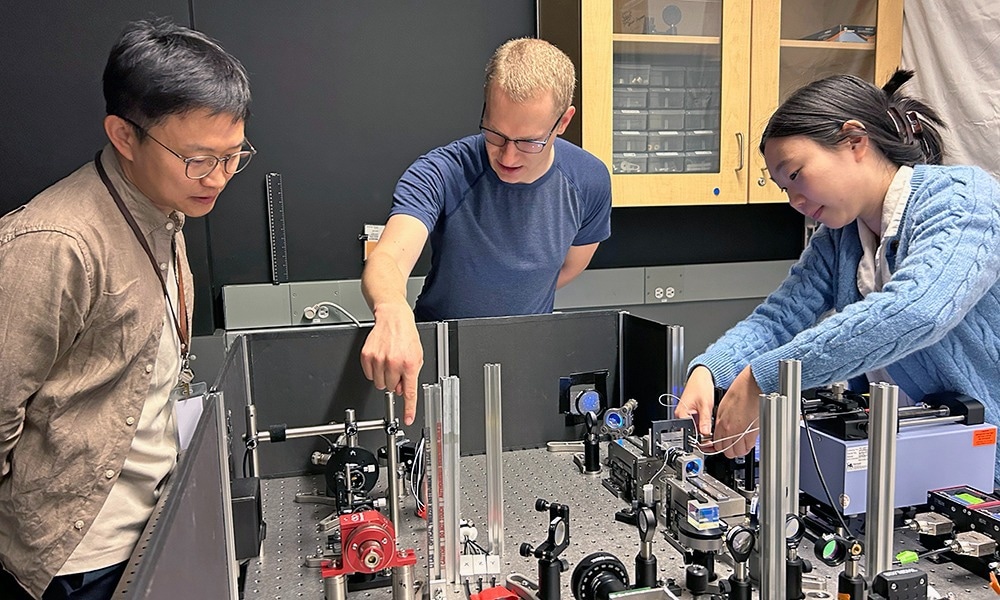Reviewed by Danielle Ellis, B.Sc.Nov 28 2024
Researchers at The University of British Columbia Okanagan have created a first-of-its-kind artificial adhesion system that closely resembles biological connections.
 Dr. Isaac Li, along with students David Bakker and Micah Yang, prepare an experiment as they work to understand counter-intuitive biological interaction like catch bonds and how cells physically interact with each other. Image Credit: The University of British Columbia
Dr. Isaac Li, along with students David Bakker and Micah Yang, prepare an experiment as they work to understand counter-intuitive biological interaction like catch bonds and how cells physically interact with each other. Image Credit: The University of British Columbia
At the Irving K. Barber Faculty of Science, Dr. Isaac Li and his colleagues investigated biophysics at the single-molecule and single-cell levels. To create novel instruments for illness diagnosis and treatment, their research aims to comprehend the physical interactions between cells and their surroundings.
Micah Yang and David Bakker, two of Dr. Li's Ph.D. students, have created a novel chemical that may change how cells attach to and interact with one another.
All cells have an inherent “stickiness” that allows them to interact, unite, and create tissues, according to Micah Yang, the study's primary author. In contrast to common glues, which tend to release more readily when applied with increasing force, many cellular adhesive interactions exhibit the reverse behavior: the stronger the hold, the harder the pull.
Known as a catch connection, this paradoxical self-strengthening stickiness is critical for supporting vital biological processes and preserving their integrity.
A pair of DNA molecules created to mimic this catch bond behavior are the subject of Yang's invention.
This DNA-based device consists of two parts: the hook and the fish. Because of its unique shape, it is known as the “fish hook.” The technique creates a catch link by using complementary DNA base-pair interactions, much like a fish biting a hook. By changing the fish's and the hook's DNA sequences, the bond's behavior can be precisely adjusted, giving people control over how strong it is under different forces.
Catch bonds play critical roles in systems like T-cell receptors and bacterial adhesions, which are key to immune responses, tissue integrity, and mechano-sensing a cell’s ability to detect and respond to physical forces. Nature has perfected these interactions over millions of years, but replicating their dynamic properties synthetically has been a major challenge until now.”
Micah Yang, Study Lead Author, The University of British Columbia
The study published in Nature Communications highlights the advantages of this novel DNA-based system.
The tunability of this system is a significant advancement over previous artificial catch bonds. The ability to precisely control the bond’s force-dependent behavior makes it an ideal tool for studying biological interactions and developing innovative materials.”
Micah Yang, Study Lead Author, The University of British Columbia
According to Yang, the fish-hook relationship has a wide range of possible uses.
The design may inspire materials scientists to develop responsive materials that strengthen under stress. This would make them perfect for wearable technology or aerospace applications where longevity is crucial.
This method could enhance tissue scaffolds or drug delivery systems in medicine by allowing them to interact force-sensitively with cells, simulating biological processes.
Although artificial adhesion bond formation is still in its infancy, Yang views it as a promising advance in biomimetic engineering, which aims to mimic the effectiveness and versatility of natural systems. This work opens new avenues for creating materials that replicate or improve biological processes.
By mimicking biological interactions like catch bond, scientists are not only learning more about how these systems work in nature, but they are paving the way for new technologies that are capable of enhancing human life.”
Micah Yang, Study Lead Author, The University of British Columbia
Source:
Journal reference:
Yang, M., et al. (2024) Engineering tunable catch bonds with DNA. Nature Communications. doi.org/10.1038/s41467-024-52749-w.